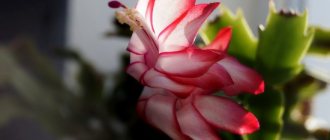Wallot is a bulbous plant belonging to the amaryllis family. Under natural conditions, it is distributed in the subtropics of South Africa. Cultivated since the 18th century. Previously, the plant was grown only in botanical gardens, but soon took pride of place on windowsills. Culture develops at an average speed. The height of an adult plant does not exceed 50 cm. Young plants with a small bulb bloom once a year - in the summer, adults are able to bloom twice per season. The attention of flower growers is attracted by the bright red buds, arranged in several pieces on an elegant tall peduncle.
Description of the flower
This unusual plant received its name from the French botanist Pierre Vallot. The elongated bulb produces belt-shaped flat leaves, no more than 3 cm wide and about 60 cm long. A distinctive feature of the flower is that the bulb in the upper part, like the base of the foliage, has a reddish tint. Peduncles, characteristic of all representatives of this family, have no leaves, grow up to 30 cm and bear from two to eight bright purple bell flowers, about 7 cm in diameter each.
For home cultivation, unusually colored forms with salmon and white flowers have been bred.
Wallot gained popularity as a decorative flower at the end of the 17th century, and since then its bulbs have become available far beyond its natural habitat. Thanks to its unpretentiousness, it takes root in any conditions, easily forming daughter bulbs.
The root system of this perennial is a bulb. It has an oval shape, scaly, brown color. Quite small in size. The sword-shaped leaf, more than half a meter long, is dark green in color, but the petiole is purple. The peduncle does not have sepals, and the inflorescence is presented in the form of an umbrella, which has from 3 to 9 single flowers.
Of its entire family, only wallot has a green-purple color palette of the leaf blade and light crimson bulbous scales of the underground root formation. A distinctive feature of wallot is the unusual way of budding daughter bulbs. In her, they come to the surface of the soil with the help of repulsive legs, unlike other representatives of the genus, in which the children appear in the depths of the earthen clod. As the wallflower bulb grows, a root ending appears, which buries the daughter formation into the soil and allows it to exist independently.
Description of the plant: what is wallot?
The wallot flower is most valued for its flowers, collected in umbels. Umbrellas are located on a hollow, strong, scaleless peduncle up to thirty centimeters long, which appears from the center of the bulb. The bulb is brown in color and has an ovoid, elongated shape. On the peduncle there are from three to nine flowers, ranging in color from orange to dark red. The size of the wallot flower reaches five to six centimeters in diameter, reminiscent of lily flowers. Consist of 6 petals and stamens, one pistil. The aroma is not strong. The leaves are long, up to 40 centimeters long and 3 cm wide, dark green. Arranged in the form of a fan.
Growing conditions
This plant is a long-liver; with good care it can live up to twenty years. For a comfortable stay, the recommended air temperature is + 20...+ 25 degrees, however, during the rest period - in winter, the temperature should be lowered to + 10... + 15 degrees. It may be necessary to spray wallote only in hot weather.
For abundant and regular flowering of wallflower, the pot with the plant should be placed on windows facing south, southwest or east. To prevent sunburn, it is recommended to shade the wallot.
Due to poor lighting, north-facing windows are not suitable. In summer, flowers in pots can be placed on balconies or verandas. However, it is necessary to protect the wallot from sudden changes in temperature, rain and hot sun.
Features of flowering
Flowering begins in mid-summer. The whole process happens very quickly, from the birth of the peduncle to the opening of the buds, fifteen to twenty days pass. The peduncle shoot grows up to two centimeters per day. The blooming flowers of the wallot do not last long, up to five days, but since they open one by one, flowering continues for several weeks.
Home care
Vallota prefers to grow on well-lit eastern window sills, and even direct sunlight is not contraindicated for it. However, in hot weather, when the temperature in the room rises above 25 ºC, the plant should be shaded from the sun.
In the warm season, the wallot reacts normally to the temperature usual for human habitation - 20-25 ºC, but during the rest period it is kept in a cool room where the temperature does not exceed 10-12 ºC. The lower temperature threshold for a plant is 5 ºC, but it cannot stay in such cold for a long time. Drafts and sudden temperature changes are contraindicated.
Location and lighting
Being of African origin, wallot needs bright sunlight. Therefore, south-eastern and south-western windows are suitable for growing flowers. An unpretentious plant is capable of developing even in partial shade, but in this case it will lag behind, and you may not be able to wait for flowering at all. In winter, you can create artificial lighting to compensate for the short daylight hours.
Wallota is a fairly light-loving flower. When choosing a location, it is important to know that the flower prefers windows facing east.
Temperature
Suitable summer temperatures range from 20-25 degrees. In winter, cooler temperatures with a range of 10 to 12 degrees are suitable.
In summer, you can safely take the flower out onto the balcony: fresh air will do you good. However, as soon as the night temperature approaches +10 degrees, the bulb should be brought to a warm place to avoid freezing.
Air humidity
In hot conditions at temperatures exceeding 25 degrees, the plant must be constantly irrigated with a spray bottle. However, drops of moisture falling on flower petals will have a bad effect on their delicate surface. Wallot leaves must be kept clean at all times. A damp cotton cloth is quite suitable for these purposes.
The plant has no complaints about air humidity, but additional spraying will be useful. It is important to periodically carry out hygiene by wiping the leaves on which dust accumulates over time with a damp cloth, and also remove wilted flower stalks.
Watering
Like all bulbous plants, wallot should be watered very carefully, avoiding waterlogging of the soil. During active growth, the plant should be watered only after the top layer of soil has dried. During winter dormancy, the lower the temperature of the bulb, the less often it is watered. However, remember that wallot does not tolerate the dying of leaves, since it is their condition that signals an incorrect watering regime.
The soil
Such a beautifully flowering plant as valotta needs increased soil nutrition, so the mixture suitable for it includes as many as 4 parts of fertile soil from under the leaf litter. The remaining parts are made up of humus, turf and 2 parts sand.
Wallot grows well in a mixture of peat and sand, but for nutritional reasons you can dilute the soil with garden humus; the plant loves organic matter. Sand will also not hurt, as it will add “airiness” to the earthen mixture. The proportion of peat, humus and sand can be 2:2:1. We make the soil ourselves. With proper maintenance, the bulb grows quickly, entwining the earthen ball with roots and forming many children, so replanting is necessary every 2-3 years into a slightly larger pot.
Feeding and fertilizers
Liquid store-bought fertilizer intended for flowering indoor plants should be used once every 14 days from spring to autumn during the flowering period of the plant.
From May to mid-autumn, once every two weeks, cirtanthus is fed with a solution of organic matter or complex mineral fertilizer for flowering indoor plants; the rest of the time, fertilizing the wallote is not needed.
Transfer
Vallotta should not be frequently replanted into fresh soil. Its underground parts are very sensitive to damage during transplantation, and the process of rotting may begin. Only when the bulb grows so large that it does not fit in the pot can it be moved to a larger container. Since daughter bulbs greatly deplete the adult bulb, it is best to separate them immediately. The upper part of the mother bulb does not need to be buried. Babies will bud on it, which can be removed as they grow.
To avoid rotting of the bulb, which is caused by excess moisture, the bottom of the pot is filled with a small drainage layer consisting of crushed bricks or pebbles. When a plant stays in a pot for a long time, the surface of the soil is sometimes covered with a white (reddish) coating of salt; these are deposits due to the high hardness of the water. They get rid of salinity by replacing the top layer of soil.
- The bulb is planted, buried in the ground no more than one-third in height.
- To keep the pot tight, which stimulates flowering, the distance from the bulb to the sides of the pot should not exceed 3-4 cm.
- Remember, the plant does not tolerate transplantation easily, so do not be alarmed that after planting the bulb will not show signs of growth for a long time. First, the wallot grows fragile roots, and only then the above-ground part.
After planting, shade the beauty, protecting it from direct rays. However, even rooted plants prefer diffused light, reacting to excess light with sunburn.
Which pot would be best for wallot?
Which pot would be best for wallflowers is a question that worries many gardeners. If a flower is planted for raising children and further propagation, then it will feel best in spacious flowerpots with good drainage. If you want to see its flowers of extraordinary beauty as soon as possible, then you should select a slightly cramped pot.
Selecting soil, pot, replanting
The roots are succulent, fragile, not very long, and easily rot. They don't need a lot of land. Therefore, wallot is replanted only when there is an urgent need, usually once every 3-4 years, in the spring.
Vallota does not like transplants
Another argument in favor of rare replanting is that the fire lily blooms better in a cramped pot. When choosing a container for a plant, choose one that is narrow but tall. A narrow pot will not allow the wallot to grow many children. In a wide area, young onions will grow in abundance. Because of this, the plant will not have enough strength to bloom. A wider container is needed when you plan to propagate wallot or plant several onions at once. Take care of the drainage holes in the pot.
If you have purchased a valotta bulb, you should plant it without delay. Evergreen varieties can survive without leaves for some time, but this existence is difficult to endure. Therefore, help the plant gain leaves faster.
Wallota is not picky about soil. But for healthy development and annual flowering, you need nutritious and loose soil and high-quality drainage: broken brick, expanded clay, clay shards, gravel, vermiculite. It will protect against putrefactive diseases. Approximate soil compositions:
- universal soil from the store with the addition of vermiculite;
- Mix 3 parts of turf soil with 2 parts of leaf soil and peat, add part of rotted mullein and sand;
- leaf and turf soil (3:2), peat and sand (2:1);
- deciduous and turf soil in half, 1 part humus and sand;
- mix equally turf, leaf soil and sand, instead of which chopped sphagnum is suitable;
- equal parts of peat, leaf and turf soil and half of sand and manure.
How to plant wallot
- Before planting, sterilize the soil (or its components separately), drainage and pot. Place a drainage layer at least 2 cm thick at the bottom, with a little soil on top.
- Remove the wallot from the old pot and carefully separate the babies.
- Lightly shake off the old soil, leaving it in the roots. Remember: they are very delicate.
- Inspect the roots, remove rotten ones, sprinkle with charcoal powder.
- Place the onion in a new container.
- Carefully fill it with soil, leaving two-thirds to half of the top above the soil level. Water the plant and place it in a slightly shaded place for better adaptation.
- When growth begins, move the wallot to a sunny windowsill.
Wallot bulbs are not deeply buried, so that later it is easier to separate the resulting children. The growth appears in the upper part, so the young onions will be almost on the surface, all that remains is to collect the “harvest” without disturbing the dormancy of the mother plant.
Preparation and flowering period
With proper care, the villota bulb produces flower stalks twice per season. The life of one stem with flowers is 5 days. At the same time, 2-3 buds can bloom at once.
In April, the wallflower will begin to wake up, this can be seen by the growth of new leaves. In this case, you can slightly increase the temperature, but avoid heat, which the wallot cannot tolerate. 20-24 °C is quite enough.
Feeding is resumed, which must be done every 14 days. The simplest and most practical option is to use ready-made complex liquid fertilizers for flowering plants.
When the plant produces a peduncle, and this will be in late spring or summer , feeding does not stop; you can replace the main preparation with a phosphorus-containing one that stimulates flowering. Watering is carried out moderately, but do not allow the top layer to dry out. The ideal condition of the soil is always slightly moist; excess water in the pan must be drained.
Types of wallots with photos
The most popular among gardeners are 2 types of wallflower, which are described in more detail below.
Vallota speciosa
The height of the bush is approximately 65 centimeters, and the flowering bulb reaches about 4.5 centimeters in diameter. The flowers are shaped like lilies. At the top, the oval petals are slightly pointed; they are deep red with an orange tint. Widely open umbrella-shaped inflorescences are directed upward. The belt-shaped dark olive leaves are approximately 40 centimeters long and about 3 centimeters wide. The beginning of flowering is observed in mid-August.
Wallota purpurea
At the same time, from 6 to 8 flowers are formed on one peduncle, reaching about 5 centimeters in diameter. The tops of the scarlet petals are pointed. Narrow green leaf plates are no more than 35 centimeters long. Flowering is observed at the beginning of autumn.
Reproduction of the valotta flower
There are two suitable ways to propagate valotta: seed and with the help of children (daughter bulbs). Wallot is rarely propagated by seeds, since in this case the plants bloom only after reaching 4-5 years of age. Therefore, the daughter bulb can bloom already in 2-3 years of life. It is better to separate the “babies” when transplanting an adult plant. They are planted in separate containers, being careful not to damage the roots! For growing, narrow containers, no more than 12 cm in diameter, are used; in wide pots, wallots bloom less readily.
It is better to transplant and separate the children in the spring before the flower stalks appear, otherwise it is advisable to postpone it until after flowering. When purchasing a bulb, pay attention to its integrity, absence of signs of rot and disease, hardness and even color. If you purchase a vegetative specimen, inspect the leaves; they should be elastic, even, without dark tips. Wallot is an unpretentious flower; in loose soil and good lighting it blooms regularly every year.
Reproduction by children
Separated children are placed in individual small containers, deepening them only two-thirds. They do not need to be watered often, especially in the first months. The bulbs will grow and begin to bloom only after 2 years.
- To do this, young bulbs are separated from the mother’s head and planted in small containers with a diameter of up to 9 cm.
- There is no need to deepen the child by more than half its height.
- Afterwards, only infrequent watering is recommended.
This method of propagation is more popular among lovers of house plants compared to seed.
Propagation by seeds
Wallot should be sown in mid-autumn in moist soil under glass. Further care will consist of regular ventilation and irrigation at a temperature of 16-18 ºС. Sprouts will appear in about a month. Seedlings that are already six months old should be picked for the first time. Small bulbs should be planted in separate pots, completely immersed in the ground. After 2 years, the young bulbs are transplanted so that the upper part is on the outside. The seed method produces plants that will bloom in the third year after sowing.
The seeds are collected in September, after full ripening, and they try to sow immediately so as not to lose germination. The composition of the soil must contain the following components: peat, rotted earth, sand.
- Before planting, seeds can be soaked for a day in a growth stimulator.
- Considering that the seeds of the wallot are quite large, they can be planted one at a time in separate cups. The plant really doesn't like being replanted, and you will thank yourself for not having to replant them later. However, many are not afraid of picking, so decide for yourself what is more convenient.
- After sowing the seeds, the container is covered with plastic wrap. Monitor the air temperature (optimal + 18°C), do not forget to ventilate and remove condensation.
- A month later the first shoots appear.
- They start diving only after six months, planting each sprout in a separate container.
- Light, non-stagnant watering will provide the seedlings with the necessary amount of moisture. In winter they need good lighting most of all. An indoor temperature maintained at 16°C will be an excellent complement to the lighting regime. Water very rarely.
After 2 years, the strengthened, grown seedlings are moved into slightly cramped pots. This is done in order to ensure flowering at an earlier date. When planting, the neck of the bulb should rise above the ground by two-thirds in height.
After 4 years, the first peduncle is expected.
What types of valotta are most often grown?
The diversity of the crop was initially represented by three species: purpurea, speciosa and miniata. But today there is only one left - beautiful valotta, also known as specioza. In the modified classification, Valotta purpurea was transferred to the genus Cirtanthus, and Valotta miniata was transferred to the genus Clivia.
The remaining species has varieties that differ in the color of the flowers, as well as in the structure of the plant itself. For example, more compact, low, or with even narrower foliage.
In indoor gardening, as well as in greenhouses, the following varieties of valotta are most often grown:
- Alba with delicate white flowers;
- Major is the largest-flowered variety with buds up to 12 cm in diameter;
- Magnifica with original white eyes inside the buds;
- Minor with the smallest flowers and narrow leaves.
Flower types
Depending on the annual cycle of the plant, all varieties of this flower can be divided into two types:
- Evergreens.
- Geophytes.
From the name of the first group of plants it is clear that they remain green all year round, therefore in our latitudes they can only grow in greenhouses or constantly migrate from the garden bed to pots for the winter. Growing the wallot plant at home is possible both in the garden and in pots on the windowsill.
Amaryllis of the second type, geophytes, lose their leaves during unfavorable periods. They are further divided into groups depending on the growing season: for some plants this period occurs in the summer months, while for others it occurs in the winter months. Caring for different types of wallot is somewhat different and has its own characteristics.
In addition, in the genus of these plants there are real “informals” that bloom only after surviving a forest fire and heavy smoke. If a fire does not occur within a year, the wallflower does not bloom, remaining in the same state for a long time. Thanks to this feature, they received their second name - fire lily.
Care - unobtrusive
Wallota, accustomed to alternating short and rare heavy rains with long droughts, can withstand a lot even at home. She is not capricious and would rather forgive the gardener for forgetfulness than for excessive love for watering and fertilizing. From such wet care, the wallot can get sick or even die.
Watering and fertilizing
Overfilling is much worse than underfilling. If there is a forced drought, the fire lily will try to slow down its growth, maybe 2-3 leaves will dry out, but the bulb itself will live and thrive until you remember about your flower. It is almost impossible to kill wallot with drought. But it is quite possible to lead to a fatal disease by regularly flooding the soil. The delicate onion easily rots.
Vallota prefers rain or melt water. But if you don’t have one, filtered or settled water will do. But definitely slightly warmed up, 2-3 degrees warmer than room temperature.
Before using a watering can, assess the condition of the soil. If the top layer has dried out, water it. It's still wet - don't add water, it'll make it worse. Water more frequently and more frequently in spring and summer. After flowering, gradually increase dry periods. During winter rest, limit watering to a minimum, just so that the leaves do not wither and die - wallot is sensitive to their loss. Be sure to remove water from the pan; “wet feet” at low temperatures will lead to flower disease.
Varieties and photos
The plant has only three varieties, for which there is still debate about where to classify them. For example, the beautiful and purple wallots were identified as a separate subspecies of citranthus, and the dwarf wallots were identified as the subspecies Clivia.
Vallota is beautiful
The plant is also called Citranthus, purple Amaryllis, beautiful Crinum. Its brown bulb is scaly and oblong in shape. The leathery leaf, 40 cm long, has the shape of a sword and is dark green in color. The stem with the inflorescence comes straight from the core of the bulb and reaches a height of 30 cm. It has no sepals, and it is empty inside. An umbrella combines 3-6 flowers at once. One bud consists of 6 petals. The petal has the following parameters: length 8, width up to 10 cm. Mostly burgundy and bright orange colors of flowers are found, the only exception is the genus Alba with white petals.
Wallotha purple
This variety has smaller leaves and flowers than other types of wallot. The perennial also has a bulb and foliage no more than three tens of centimeters in height. They are painted bright green and have a leathery surface. The diameter of one flower reaches 5-6 cm, and one bell inflorescence contains a minimum of 2 and a maximum of 8 buds. The pointed petals form a purple flower.
Vallota white
This species is very easy to confuse with a lily. Although the flowers of the bush are not pure white, but with a cream tint. The leaves are xiphoid, bright green. 5-7 flowers are formed on the peduncle. Blooms in spring or autumn.
Wallot pink
The rarest type. In all external characteristics, it is similar to white valotta, but differs only in the soft pink shade of the flowers.
Transplantation, propagation, flowering
Transfer
The rules for transplanting this genus are somewhat different from the same procedure with other plants:
ADVICE! The main rule: African impatiens should be replanted as rarely as possible - it tolerates this procedure very poorly due to the fragility of the roots.
It is not worth replanting plants of this kind for another important reason - in a large pot the flower will not want to form flower stalks. He will take care of raising children.
In case of emergency, the procedure should be carried out as carefully as possible, trying not to touch the roots. With the slightest damage, the root will no longer grow and will gradually die.
When transplanting the bulb, do not place it completely in the ground (ideally one third). At the beginning of the procedure, separate all existing babies that can be placed in other vessels. And good drainage is very important.
Choosing a pot
When choosing a pot in which the plant will live and bloom, you should be guided by the fact that flowering is possible only in a cramped container.
Therefore, the pot should be only a few centimeters larger than the bulb itself.
Reproduction
The easiest and fastest way to reproduce an African beauty is with children. They are formed in any specimen in sufficient quantities.
But only those that have already formed their own roots are suitable for planting.
These babies need to be planted in small containers (up to 10 cm) according to the same rules as adult bulbs, and with the same precautions. With this method of propagation, flowering can be expected within two years.
In addition to this method, propagation by seeds and division of the bulb is possible, but this requires a lot of experience and a long time.
Bloom
Any time during the active period is suitable for flowering for this genus. If the plant is provided with proper care, it can form flower stalks twice during the active season.
INTERESTING! The number of future peduncles is determined by the leaves: three pairs of leaves will ensure the development of one arrow, six pairs will correspond to two peduncles, and so on.
Typically, up to 9 flowers are formed on one peduncle, shaped like a funnel or bell. No more than three of them can open at a time.
Why doesn’t the wallflower bloom and what to do?
To ensure flowering, representatives of this genus cannot be transplanted into large containers.
ATTENTION! This beauty from Africa blooms only in a cramped pot. If there is enough space, it begins to form numerous children - then flowering is not expected.
The lack of flowering may be due to the presence of children on the bulb - they should be carefully separated, or the lack of a dormant period for the plant - it is necessary to reconsider its regime.
Diseases and pests
Wallot is highly susceptible to root rot due to waterlogging of the soil and the presence of pathogens of this disease in the soil. Therefore, it is better to plant the bulbs in previously disinfected soil. Most needed for young bulbs.
Excess moisture in the soil in winter often causes gray rot. It is not uncommon for aphids, spider mites and scale insects to infest wallot.
Why do the leaves of a flower turn yellow?
How to care for a wallot flower and what should be the conditions for its growth? Like all other bulbous crops, this plant needs care and certain environmental conditions. So, one of the main conditions for the good existence and abundant flowering of this plant is bright lighting.
Direct sunlight in the first half of the day is highly desirable for wallot, but partial shade is quite acceptable in the afternoon. When placed on window sills at home, eastern windows are preferable or, as a last resort, western ones. But plants located on southern window sills may burn; on northern windowsills, additional lighting will be required.
Yellow leaf tips
Leaves signal problems with roots! Perhaps there is overmoistening, and dark ends are the first signal of problems. Adjust watering depending on the time of year, because waterlogging most often occurs in winter. Dense leaves can wilt from low temperatures, because this bulbous plant loves warmth. If multiple problems with leaves are observed, you should pay attention to the “diseases of indoor flowers” page to exclude the possibility of fungal or bacterial diseases.
If it doesn't bloom
For flowering, a cool winter, good lighting and a proportionate pot are crucial. In order for a flower stalk to appear, the plant must absorb the entire volume of soil in the pot and grow roots. However, the reason may also be that the container is too tight; in this case, the bulb simply does not have enough nutrition to bloom. Flowering is usually preceded by a period of rest in coolness and minimal humidity. This winter “rest” promotes the formation of flower stalks.
Features of caring for wallot also require compliance with the temperature regime. In summer, the optimal temperature is a thermometer reading of 22-24 °C. Wallot leaves turn yellow and even begin to fall off if the air temperature exceeds this figure. In winter, it is advisable to place evergreen species growing at home in a bright but cool room with an air temperature of 7–10 °C. This could be, for example, an insulated loggia. Bulbs of deciduous plants of this species must be removed from any frost-free room with a temperature of at least 5°C.
Problems during cultivation
When growing wallot, some problems are possible, even despite its unpretentiousness:
- As stated above, if there is no flowering, the plant can be transplanted into a smaller pot. You also need to adjust the temperature and lighting conditions.
- With low humidity, the tips of the leaves may turn yellow. Spraying will bring everything back to normal.
- Overmoistening of the soil leads to rotting of the base of the bulb.
- Fertilizing can correct the problem of drooping and pale leaves.
- Yellowing and falling leaves may indicate recent replanting or non-compliance with watering measures.
Description of room conditions
Valotta loves an abundance of light, so it will grow well on western and eastern windows. In the warm season, you can give the plant a walk - take the pot out into the fresh air. Some gardeners say that they plant wallot in open ground in the spring and return it to its place in the fall. But the majority are opponents of such experiments. Why? The explanation is simple: the plant does not tolerate transplantation well, so you should not create unnecessary stress.
Table: seasonal conditions favorable for the flower
| Season | Lighting | Humidity | Temperature |
| Spring | The bright, best place for wallot is the western and eastern window sills; the southern ones will require a little shading. In the north, lighting is required. | Moderate, 50–60%. Vallotta does not need additional moisture. Wipe the leaves with a damp sponge or cloth. Sometimes, in extreme heat, spray the plant. During flowering, avoid getting water on the flowers, which can cause them to die. | Moderate, at least +20 degrees. |
| Summer | Bright, diffused. Protect from hot midday sun. | Moderate, +20–25 degrees. You can place the wallot on a warm balcony, veranda or in the garden. But be sure to bring it indoors when it gets cold. The plant does not tolerate large differences in day and night temperatures. | |
| Autumn | |||
| Winter | Bright. A little direct sun is helpful. The southern direction is suitable. On north-facing windows, the wall needs artificial lighting. | Cool, 12–16 degrees. Don't let it go below 10. Higher temperatures may prevent flowering. Deciduous forms of wallot are stored in the form of bulbs at a temperature of +5. Getting used to the “spring” temperature is carried out gradually. |
Vallota willingly takes sunbathing and feels great on a southern windowsill
Poisonous properties of the plant
The leaves, roots, even flowers of the plant are saturated with toxins . Wallot bulbs contain the highest concentration of poisonous juice. The active ingredient is the alkaloid lycorine. Large doses cause vomiting, upset stomach, intestines, and diarrhea.
If the juice of the plant gets on the skin, it turns red and begins to itch. All manipulations with cirtanthus involve the use of rubber gloves. After completing the transplant, you should wash your hands and used instruments with soap.
Attention! Children and animals need to be supervised so that they do not touch the plant.
Using cirtanthus in interior design
Most often, wallot is planted in separate pots. One container can contain several onions or one or two. Ensembles with succulents look good next to fire lilies of different shades.
These are bushes with thick leaves: aloe, kalanchoe, dollar or money tree.
In summer, pots with cirtanthus are placed next to original stones and wooden products. The plant loves fresh air. Often, pots with bright bells are placed in flower beds and even hung in flowerpots.
Why wallot does not bloom and what to do
A beauty may refuse to bloom for several reasons:
- The chosen container for the flower (pot) is too large and the plant switches to reproducing children.
- The plant has not been replanted for a long time. There are a lot of kids that are distracting and sucking out all the nutrients.
- The rest period has not been maintained. The plant has not had enough rest to accumulate strength for flowering.
Only strict adherence to all recommendations for replanting, watering, and fertilizing will bring results. Then the wallot is able to attract attention with its flowering more than once a year.
Rest period
Bulbous plants cannot bloom constantly; moreover, after the flowering period ends, the plant needs to recuperate. Vallota is no exception. This flower is characterized by a seasonal rhythm of life - alternating growth phases and resting phases. The task of the gardener in this situation is to correctly understand the needs of the plant and provide it with optimal conditions corresponding to each phase.
The resting phase begins almost immediately after the last flower is dropped. But it’s worth preparing for it in advance, about 2 weeks in advance, starting to gradually change the watering and fertilizing regime in order to provide the flower with such care by the end of this period that:
- watering is limited, but not completely stopped; the plant should receive a minimum of moisture, preventing the bulb from drying out completely, but not giving it strength to grow;
- feeding - stopped;
- temperature - reduced to +12–15 ºC (some species need even cooler air).
However, changing the temperature regime in the resting phase is not critical for wallflower; much more important is reducing the intensity of watering and fertilizing.
However, it is worth putting the pot in a darker and cooler place, if only because in this phase the flower completely loses its decorative effect and is not at all pleasing to the eye. At the beginning of the growing season (depending on the type - from late winter to mid-spring, as soon as the first green shoots appear on the surface of the soil), the flowerpot is returned to the sunny side and watered, and in this case no adaptation period is necessary. The exception is the situation when the wallot was transplanted before the awakening began.
Did you know? Some varieties of wallot, especially those obtained by crossing with other plants, have their own “views” on the seasonal change of phases of life. For example, there are hybrids that bloom in winter and, accordingly, hibernate in summer. But the most unusual, perhaps, is the so-called “fire lily,” which blooms only when there is a strong fire and there is a large amount of smoke in the air.
Unlike many other flowering plants, cirtanthus should not completely shed its foliage during the dormant phase. Moreover, if you cut it, the flower will react to such a procedure very painfully. However, slightly wilted and dried leaves during this period are considered normal, and there is no need to worry about this.
It is also important to know that the alternation of periods of growth and rest described above is typical only for adult specimens. Young bulbs should be watered and fed throughout the year without interruption, so they will form faster and reach the size necessary to begin flowering.











